Mild Traumatic Brain Injury Induces Transient, Sequential Increases in Proliferation, Neuroblasts/Immature Neurons, and Cell Survival: A Time Course Study in the Male Mouse Dentate Gyrus
- PMID: 33488351
- PMCID: PMC7817782
- DOI: 10.3389/fnins.2020.612749
Mild Traumatic Brain Injury Induces Transient, Sequential Increases in Proliferation, Neuroblasts/Immature Neurons, and Cell Survival: A Time Course Study in the Male Mouse Dentate Gyrus
Abstract
Mild traumatic brain injuries (mTBIs) are prevalent worldwide. mTBIs can impair hippocampal-based functions such as memory and cause network hyperexcitability of the dentate gyrus (DG), a key entry point to hippocampal circuitry. One candidate for mediating mTBI-induced hippocampal cognitive and physiological dysfunction is injury-induced changes in the process of DG neurogenesis. There are conflicting results on how TBI impacts the process of DG neurogenesis; this is not surprising given that both the neurogenesis process and the post-injury period are dynamic, and that the quantification of neurogenesis varies widely in the literature. Even within the minority of TBI studies focusing specifically on mild injuries, there is disagreement about if and how mTBI changes the process of DG neurogenesis. Here we utilized a clinically relevant rodent model of mTBI (lateral fluid percussion injury, LFPI), gold-standard markers and quantification of the neurogenesis process, and three time points post-injury to generate a comprehensive picture of how mTBI affects adult hippocampal DG neurogenesis. Male C57BL/6J mice (6-8 weeks old) received either sham surgery or mTBI via LFPI. Proliferating cells, neuroblasts/immature neurons, and surviving cells were quantified via stereology in DG subregions (subgranular zone [SGZ], outer granule cell layer [oGCL], molecular layer, and hilus) at short-term (3 days post-injury, dpi), intermediate (7 dpi), and long-term (31 dpi) time points. The data show this model of mTBI induces transient, sequential increases in ipsilateral SGZ/GCL proliferating cells, neuroblasts/immature neurons, and surviving cells which is suggestive of mTBI-induced neurogenesis. In contrast to these ipsilateral hemisphere findings, measures in the contralateral hemisphere were not increased in key neurogenic DG subregions after LFPI. Our work in this mTBI model is in line with most literature on other and more severe models of TBI in showing TBI stimulates the process of DG neurogenesis. However, as our DG data in mTBI provide temporal, subregional, and neurogenesis-stage resolution, these data are important to consider in regard to the functional importance of TBI-induction of the neurogenesis process and future work assessing the potential of replacing and/or repairing DG neurons in the brain after TBI.
Keywords: LFPI; TBI; dentate gyrus; neurogenesis; proliferation.
Copyright © 2021 Clark, Yun, Acquah, Kumar, Metheny, Paixao, Cohen and Eisch.
Conflict of interest statement
The authors declare that the research was conducted in the absence of any commercial or financial relationships that could be construed as a potential conflict of interest.
Figures
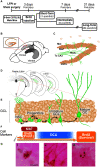
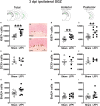
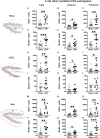
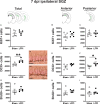
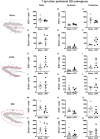
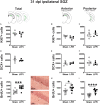
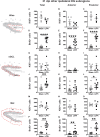

Similar articles
-
Neuronal deletion of phosphatase and tensin homolog in mice results in spatial dysregulation of adult hippocampal neurogenesis.Front Mol Neurosci. 2023 Dec 7;16:1308066. doi: 10.3389/fnmol.2023.1308066. eCollection 2023. Front Mol Neurosci. 2023. PMID: 38130682 Free PMC article.
-
Absence of the Neurogenic Response to a Repeated Concussive-Like Injury and Associated Deficits in Strategy Flexibility.J Neurotrauma. 2025 Jun;42(11-12):952-973. doi: 10.1089/neu.2024.0405. Epub 2025 Feb 17. J Neurotrauma. 2025. PMID: 39960809
-
Gliptins normalize posttraumatic hippocampal neurogenesis and restore cognitive function after controlled cortical impact on sensorimotor cortex.Biomed Pharmacother. 2023 Sep;165:115270. doi: 10.1016/j.biopha.2023.115270. Epub 2023 Aug 4. Biomed Pharmacother. 2023. PMID: 37544280
-
Adult Hippocampal Neurogenesis and Affective Disorders: New Neurons for Psychic Well-Being.Front Neurosci. 2021 Jun 16;15:594448. doi: 10.3389/fnins.2021.594448. eCollection 2021. Front Neurosci. 2021. PMID: 34220412 Free PMC article. Review.
-
Survey of transcriptome analyses of hippocampal neurogenesis with focus on adult dentate gyrus stem cells.Front Cell Dev Biol. 2025 May 30;13:1605116. doi: 10.3389/fcell.2025.1605116. eCollection 2025. Front Cell Dev Biol. 2025. PMID: 40519263 Free PMC article. Review.
Cited by
-
Traumatic brain injury promotes neurogenesis at the cost of astrogliogenesis in the adult hippocampus of male mice.Nat Commun. 2024 Jun 18;15(1):5222. doi: 10.1038/s41467-024-49299-6. Nat Commun. 2024. PMID: 38890340 Free PMC article.
-
Neural stem cell therapy for brain disease.World J Stem Cells. 2021 Sep 26;13(9):1278-1292. doi: 10.4252/wjsc.v13.i9.1278. World J Stem Cells. 2021. PMID: 34630862 Free PMC article. Review.
-
High-rate mechano-stimulation alters proliferation- and maturation-related signaling of oligodendrocyte precursor cells in a 3D hydrogel.Mechanobiol Med. 2025 Mar 11;3(3):100126. doi: 10.1016/j.mbm.2025.100126. eCollection 2025 Sep. Mechanobiol Med. 2025. PMID: 40519865 Free PMC article.
-
Adult Born Dentate Granule Cell Mediated Upregulation of Feedback Inhibition in a Mouse Model of Traumatic Brain Injury.J Neurosci. 2022 Sep 14;42(37):7077-7093. doi: 10.1523/JNEUROSCI.2263-21.2022. Epub 2022 Aug 24. J Neurosci. 2022. PMID: 36002261 Free PMC article.
-
Repeated mild traumatic brain injury causes sex-specific increases in cell proliferation and inflammation in juvenile rats.J Neuroinflammation. 2023 Oct 31;20(1):250. doi: 10.1186/s12974-023-02916-5. J Neuroinflammation. 2023. PMID: 37907981 Free PMC article.
References
-
- Acosta S. A., Tajiri N., Shinozuka K., Ishikawa H., Grimmig B., Diamond D. M., et al. (2013). Long-term upregulation of inflammation and suppression of cell proliferation in the brain of adult rats exposed to traumatic brain injury using the controlled cortical impact model. PLoS One 8:e53376. 10.1371/journal.pone.0053376 - DOI - PMC - PubMed
-
- Arguello A. A., Harburg G. C., Schonborn J. R., Mandyam C. D., Yamaguchi M., Eisch A. J. (2008). Time course of morphine’s effects on adult hippocampal subgranular zone reveals preferential inhibition of cells in S phase of the cell cycle and a subpopulation of immature neurons. Neuroscience 157 70–79. 10.1016/j.neuroscience.2008.08.064 - DOI - PMC - PubMed
Grants and funding
LinkOut - more resources
Full Text Sources
Other Literature Sources

